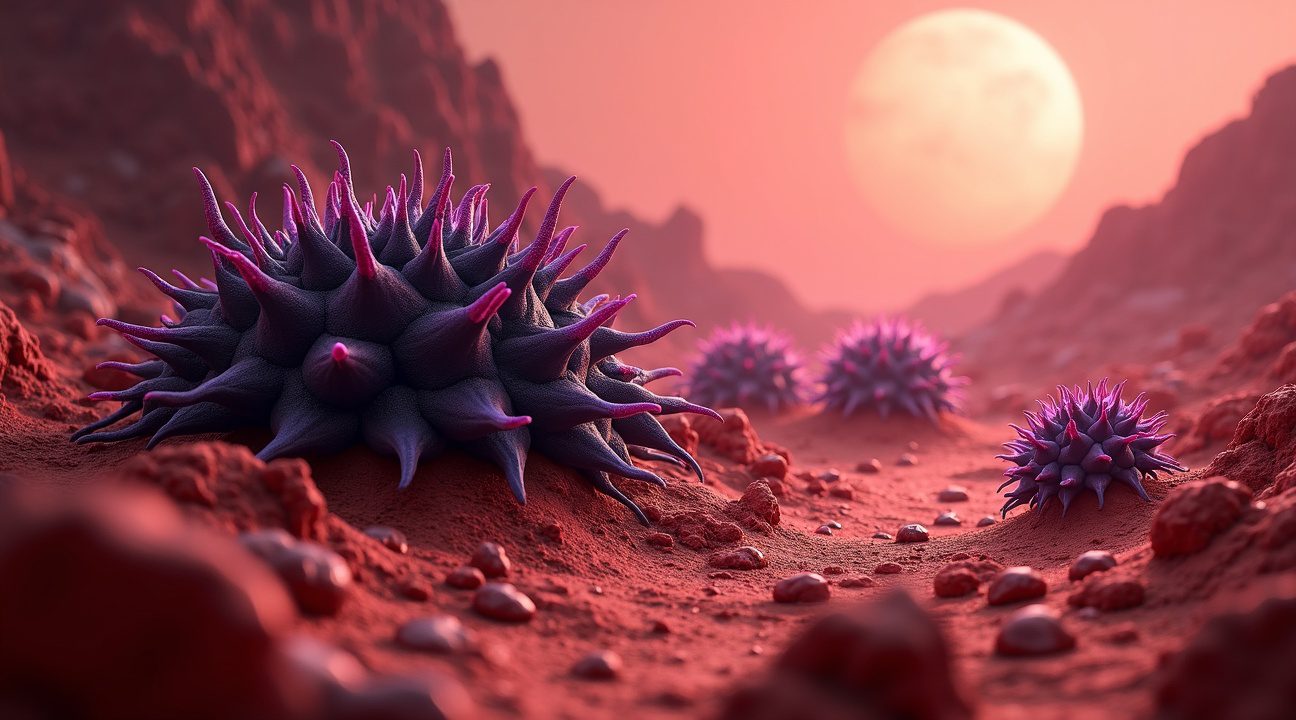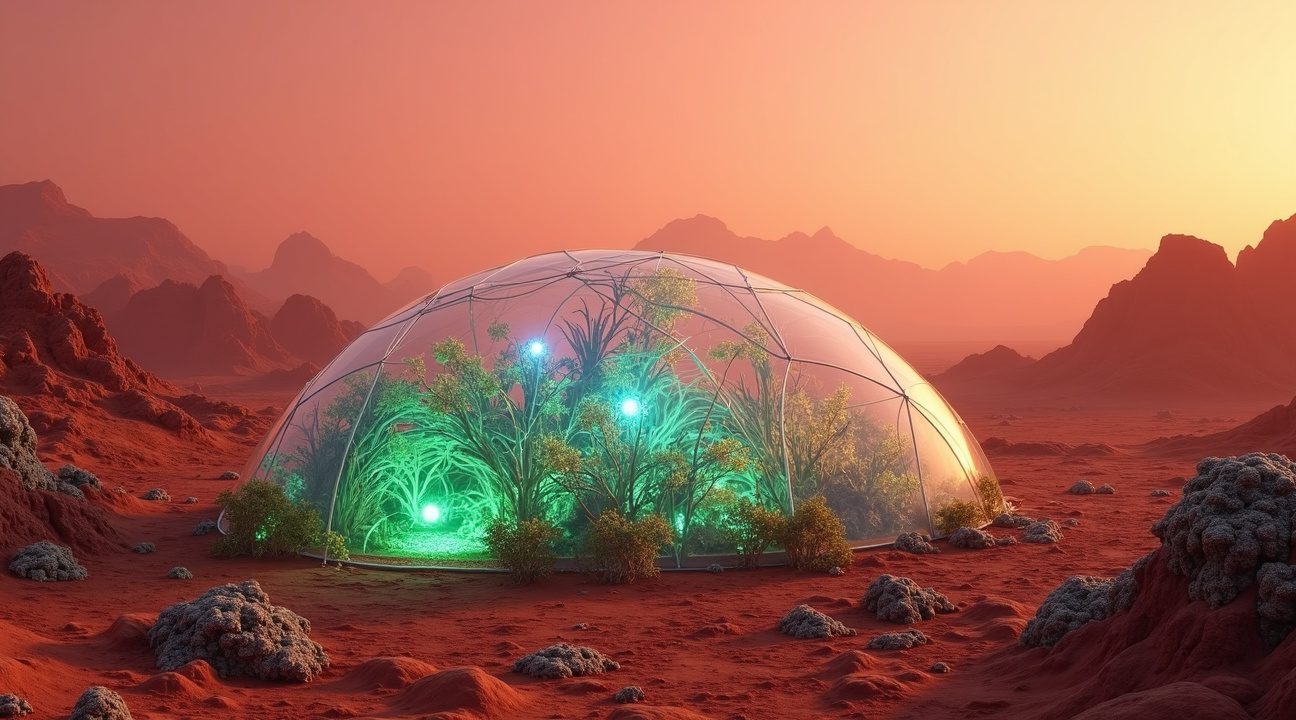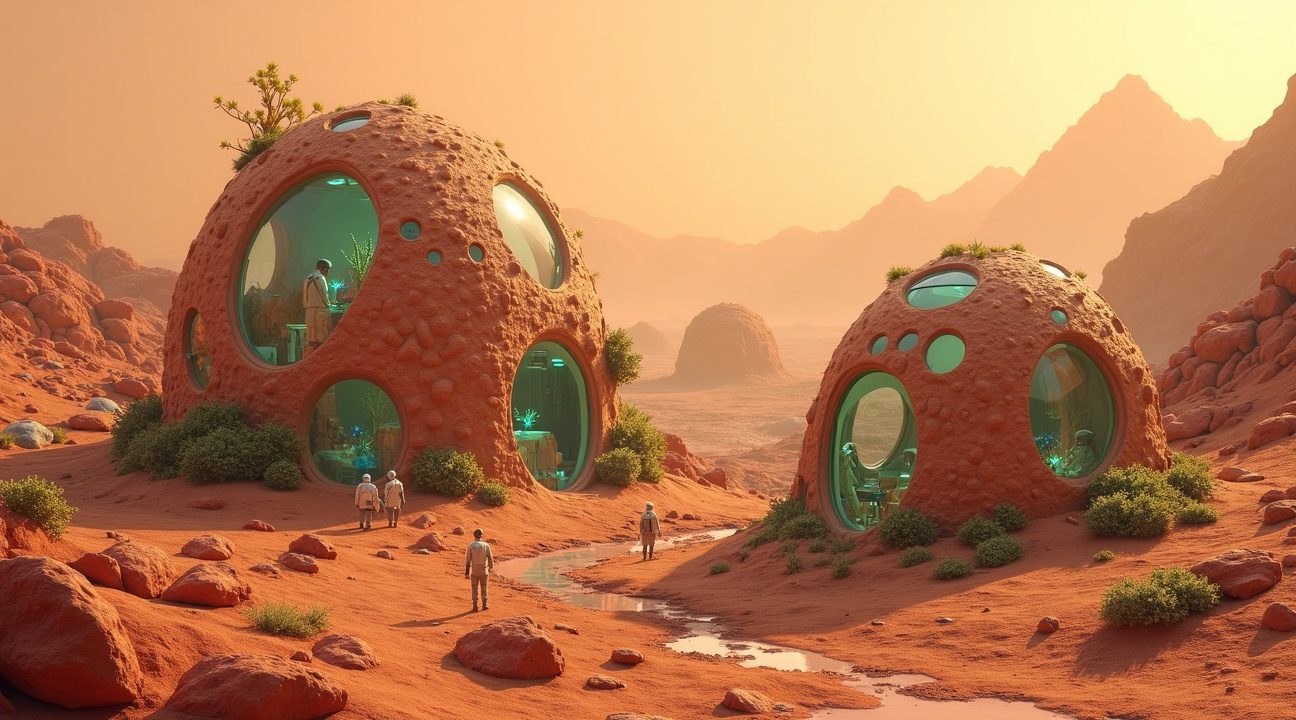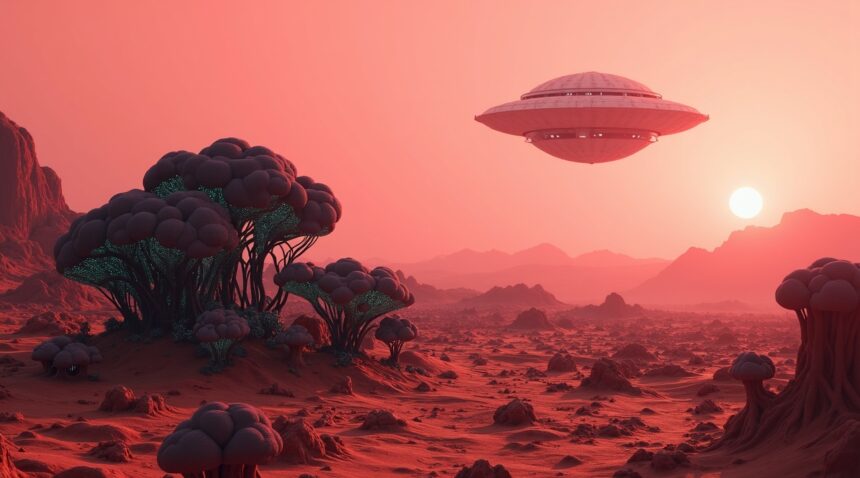Scientists have discovered that certain fungi, especially when paired with cyanobacteria, can survive harsh Mars-like conditions, producing oxygen and transforming toxic dust into breathable air — marking a major breakthrough in sustainable Mars colonization.
Key Takeaways
- Extremophile fungi like Rhinocladiella similis can survive Mars conditions by developing melanin shields and transforming into resilient yeast-like forms that resist radiation and toxic perchlorates.
- Fungal-cyanobacteria partnerships create oxygen from the Martian atmosphere while stabilizing regolith by binding metal ions found in dust particles.
- NASA’s myco-architecture program leverages dormant fungal spores that can be activated with water on Mars to construct self-repairing, oxygen-producing habitats.
- 3D printing with living microbial inks enables the creation of structures that use Martian regolith, offering self-healing buildings that actively generate breathable air.
- Updated planetary protection protocols are essential to address the contamination risks posed by Earth-based fungi while developing biomarkers to distinguish between terrestrial and Martian life.
Fungi: Nature’s Mars Survivalists
Space exploration faces a critical challenge: transforming the hostile Martian environment into one suitable for human habitation. Recent scientific breakthroughs demonstrate that certain fungi possess extraordinary capabilities that could solve multiple colonization problems simultaneously. These biological solutions offer unprecedented advantages over traditional mechanical life support systems.
Research teams have identified specific fungal species that thrive in conditions mimicking Mars’ extreme environment. Rhinocladiella similis produces melanin compounds that create natural radiation shields while maintaining cellular function in temperatures well below freezing. This black pigment acts as a biological armor against cosmic radiation that would otherwise destroy living tissue.
Adaptive Morphology
Fungi demonstrate remarkable adaptability through morphological changes that enhance survival. These organisms shift from their typical filamentous growth pattern to compact yeast-like forms when exposed to perchlorate salts found abundantly in Martian soil. This transformation reduces surface area exposure while maintaining metabolic activity essential for oxygen production.
Biological Systems for Oxygen Production
Scientists have engineered symbiotic relationships between fungi and cyanobacteria that create powerful atmospheric processors. Cyanobacteria excel at photosynthesis using the limited sunlight available on Mars, while fungi provide protective housing and nutrient cycling. This partnership generates oxygen while simultaneously detoxifying harmful compounds in the Martian atmosphere.
The biological systems process carbon dioxide directly from Mars’ thin atmosphere, converting it into oxygen through enhanced photosynthetic pathways. Fungi contribute by creating microenvironments that concentrate atmospheric gases, improving efficiency rates beyond what either organism could achieve independently. This biological approach requires no external energy sources or complex machinery.
NASA’s Myco-Architecture Program
NASA’s myco-architecture initiative represents a paradigm shift in construction technology for space exploration. Dormant fungal spores remain viable for extended periods without requiring life support during transport. Upon arrival at Mars, simple water addition activates these spores, initiating rapid growth that forms structural materials.
Living buildings grown from fungal materials offer distinct advantages over traditional construction methods. These structures self-repair damage from meteorite impacts or extreme temperature fluctuations. Fungal walls actively produce oxygen while filtering harmful particles from the air inside habitats. The buildings literally breathe, creating healthier living environments for colonists.
3D Printing with Living Inks
3D printing technology combined with living microbial inks enables precise construction of complex structures. Scientists have developed bio-inks containing fungal spores mixed with nutrients that support growth after printing. These materials harden into durable construction components while maintaining biological activity throughout their lifespan.
Printed structures incorporate local Martian regolith as aggregate material, reducing the need for transport from Earth. Fungi bind soil particles together, creating composite materials stronger than concrete while remaining lightweight. This biological cement continues strengthening over time as fungal networks expand throughout the structure.
Purifying Air and Enhancing Atmosphere
Mars colonization benefits significantly from fungal air purification capabilities. These organisms actively remove toxic heavy metals from dust particles that pose serious health risks to human respiratory systems. Fungal enzymes break down perchlorate compounds, transforming them into harmless byproducts while extracting useful minerals for biological processes.
Atmospheric processing through fungal systems creates positive feedback loops that improve environmental conditions over time. Each generation of fungi produces more oxygen while binding additional soil particles, gradually transforming local microclimates. This progressive improvement reduces dependence on Earth-supplied life support systems.
Planetary Protection Protocols
Planetary protection protocols require significant updates to address the implications of introducing resilient Earth organisms to Mars. Scientists must balance the benefits of fungal colonization technology with the risk of contaminating potential indigenous Martian ecosystems. Current sterilization procedures may prove insufficient for organisms specifically adapted to survive extreme conditions.
New detection methods help distinguish between Earth-origin fungi and any potential Martian life forms. Genetic markers specific to Earth organisms provide clear identification tools for future missions. These biomarkers ensure that scientists can differentiate between intentional biological introductions and accidental contamination events.
Field Testing and Future Deployment
Research continues into optimizing fungal systems for Mars deployment. Scientists work to enhance oxygen production rates while maintaining organism resilience under Martian conditions. Genetic modifications focus on improving efficiency without compromising the natural advantages these organisms already possess.
Field testing in Mars-analog environments validates laboratory results under realistic conditions. Desert locations with high radiation exposure and extreme temperatures provide testing grounds for fungal survival systems. These trials demonstrate practical applications while identifying potential challenges before actual Mars deployment.
Looking Ahead: Integration and Impact
Future missions will likely incorporate fungal technology as standard equipment rather than experimental additions. The versatility of these biological systems addresses multiple critical needs through single deployments. This efficiency factor makes fungi attractive options for resource-limited space missions where every kilogram of payload carries premium value.
Commercial space companies show increasing interest in biological life support technologies. Private Mars colonization efforts could implement fungal systems earlier than government missions due to reduced regulatory constraints. This accelerated timeline could provide valuable operational data for larger-scale implementations.
Educational institutions worldwide study fungal space applications, training the next generation of astro-biologists. University research programs focus on practical applications while advancing fundamental understanding of extremophile organisms. This academic foundation ensures continued innovation in biological space technologies.
International cooperation enhances fungal research through shared resources and expertise. Different countries contribute unique perspectives and capabilities that accelerate development timelines. Collaborative efforts reduce costs while improving safety through diverse peer review processes.
Conclusion: Fungi as Catalysts for Space Innovation
The integration of fungal systems into Mars exploration represents a fundamental shift from purely technological solutions to biological alternatives. These living systems offer sustainability advantages that mechanical equipment cannot match. Fungi essentially turn Mars into a partner in creating habitable conditions rather than an obstacle to overcome.
Success in implementing fungal technologies for Mars colonization could revolutionize Earth-based applications as well. Extreme environment remediation, sustainable construction materials, and atmospheric processing technologies developed for space exploration often find terrestrial applications. This dual-purpose development justifies research investments through multiple potential benefits.
Extremophile Fungus Survives Mars-Like Conditions and Produces Protective Molecular Shield
Scientists have identified a remarkable black fungus called Rhinocladiella similis that demonstrates extraordinary resilience in conditions mimicking Mars. This extremophile organism doesn’t just endure the harsh Martian environment—it actively transforms itself to create sophisticated biological defenses against threats that would destroy most Earth-based life forms.
Adaptive Transformation Under Martian Stress
Under Martian conditions, R. similis undergoes a dramatic cellular transformation that fundamentally changes its structure and function. Studies in proteomics and metabolomics reveal that this fungus shifts from its typical form into a yeast-like configuration when exposed to the extreme stresses found on Mars. This morphological change represents more than simple adaptation—it’s a complete cellular restructuring that enables survival in an environment filled with toxic salts and deadly radiation.
The fungus demonstrates exceptional tolerance to magnesium perchlorate, a highly toxic salt that saturates Martian soil and poses significant challenges for potential life forms. While perchlorates typically disrupt cellular membranes and interfere with biological processes, R. similis has developed mechanisms to not only withstand these compounds but potentially utilize them in its survival strategy.
Laboratory experiments consistently show that R. similis exhibits superior perchlorate tolerance compared to other fungal species, including Exophiala sp. strain 15Lv1. This enhanced resistance stems from multiple coordinated defense systems that activate under stress conditions, creating a comprehensive protective response that shields the organism from environmental threats.
The fungus also withstands intense UV-C radiation exposure, which on Mars reaches levels that would quickly sterilize most biological material. While Earth’s atmosphere filters out most harmful UV radiation, Mars lacks this protective barrier, making radiation resistance crucial for any organism attempting to survive on the planet’s surface. The ability to endure such radiation exposure suggests that R. similis could potentially thrive in environments where other life forms would quickly perish.
Central to the fungus’s survival strategy is its production of protective melanin pigments, which form a molecular shield around cellular structures. This melanin doesn’t simply provide passive protection—it actively neutralizes reactive oxygen species that would otherwise damage essential cellular components. The melanin barrier also helps stabilize cellular membranes in highly saline environments, preventing the structural breakdown that typically occurs when cells encounter concentrated salt solutions.
Additional defense mechanisms include:
- Upregulation of laccase enzymes – These enzymes play critical roles in managing oxidative stress and work in tandem with melanin to neutralize harmful agents.
- Production of peptidyl–prolyl cis–trans isomerases – These specialized proteins help maintain cellular stability under the destabilizing effects of perchlorates and radiation.
This comprehensive defense system represents a potential breakthrough for understanding how life might adapt to extraterrestrial environments. The discovery of such resilient organisms expands our understanding of life’s limits and suggests that similar adaptations might be possible for other species under carefully controlled conditions.
The implications extend beyond simple survival, as colonization efforts could potentially benefit from organisms capable of transforming hostile environments into more habitable spaces. The fungus’s ability to process Martian materials while maintaining biological functions offers insights into how future terraforming efforts might proceed.
Research into extremophiles like R. similis continues to reveal surprising capabilities that challenge conventional assumptions about life’s requirements. These discoveries parallel other findings about life in extreme environments, from Saturn’s moons to Earth’s most inhospitable regions, suggesting that life’s adaptability far exceeds previous estimates.
The fungus’s success in laboratory simulations of Martian conditions provides concrete evidence that complex biological systems can adapt to environments previously considered completely hostile to life. This adaptability opens new possibilities for both understanding life’s limits and developing practical applications for future space exploration missions.

Revolutionary Cyanobacteria-Fungi Partnership Creates Oxygen and Cleans Martian Air
Scientists have uncovered a fascinating biological partnership that could transform Mars exploration forever. Filamentous fungi working in symbiotic relationships with diazotrophic cyanobacteria create a powerful system for extraterrestrial air purification and oxygen generation. I find this discovery particularly exciting because it addresses two critical challenges for human settlement on Mars: breathable air and environmental cleanup.
The cyanobacteria component of this partnership performs the heavy lifting in atmospheric processing. These remarkable microorganisms fix atmospheric CO₂ and N₂ directly from the Martian environment, releasing oxygen as a byproduct while simultaneously supplying organic nutrients that fuel fungal growth. This process creates a self-sustaining cycle where each organism supports the other’s survival and productivity.
Fungal Contributions to Martian Surface Stability
The fungi bring their own essential capabilities to this biological alliance. They bind metal ions present in Martian dust and serve as biomineralization sites, effectively consolidating loose Martian regolith into hardened, stable structures. This dual function addresses both atmospheric and geological challenges that future Mars missions will face.
The binding of metal ions by fungi proves particularly valuable for cleaning Martian air of potentially harmful particles. As these organisms process the surrounding environment, they capture and neutralize metallic contaminants that could pose health risks to human settlers. The biomineralization process simultaneously creates stronger surface materials from the loose dust that currently dominates the Martian landscape.
Enhanced Systems Through Engineered Lichen Organisms
Microalgae derived from lichens and specially engineered lichen organisms demonstrate remarkable photosynthetic capability under simulated Mars conditions. These systems contribute multiple benefits that extend far beyond simple oxygen production:
- Oxygen generation for breathable atmosphere creation
- Potential food sources for sustained human presence
- Biomass production for various construction and manufacturing needs
- Critical support components for closed-loop life systems
Some of these biological systems operate with stunning independence, thriving solely on Martian regolith simulant, atmospheric gases, available light, and basic inorganic liquid medium. They function completely without human input, making them ideal candidates for pre-deployment on Mars before human arrival. This autonomous operation means colonization efforts could begin establishing breathable environments years before astronauts set foot on the planet.
The photosynthetic activity within these systems increases carbonate ion levels in the surrounding environment, creating chemical conditions that support further biological processes. Cyanobacteria-secreted biopolymers enhance interactions with Martian dust, improving the overall efficiency of atmospheric processing and surface stabilization.
This biological approach offers significant advantages over purely mechanical air purification systems. The organisms self-replicate, self-repair, and adapt to environmental changes without requiring complex maintenance protocols or replacement parts shipped from Earth. They consume local resources and convert them into useful products, creating a sustainable foundation for long-term human presence on Mars.
The potential applications extend beyond initial settlement phases. As these organisms establish themselves and multiply, they could gradually transform larger areas of the Martian surface, creating expanding zones of improved air quality and structural stability. The oxygen production capacity could eventually support not just breathing requirements but also fuel production for return missions to Earth.
Research into these biological systems continues advancing rapidly, with scientists exploring optimal growth conditions, genetic modifications for enhanced performance, and integration strategies with existing life support technologies. The combination of natural biological processes with targeted engineering creates unprecedented opportunities for making Mars more hospitable to human life while utilizing only resources already present on the planet.
Future space exploration missions will likely incorporate these biological systems as standard components, fundamentally changing how humans approach planetary settlement and atmospheric modification.

NASA’s Myco-Architecture Plans Self-Growing Mars Habitats Using Fungal Networks
NASA has embraced an extraordinary approach to building homes on Mars that sounds more like science fiction than reality. The space agency’s myco-architecture initiative represents a revolutionary step forward in creating self-sustaining habitats using fungal networks that could fundamentally change how humans establish permanent settlements on the Red Planet.
Dormant Spores Transform Into Living Architecture
The concept centers around packing dormant fungal spores into lightweight containers that astronauts can transport to Mars with minimal cargo space requirements. Once these spores reach their destination, crews activate them simply by adding water, triggering a biological construction process that builds habitats from the inside out. This approach eliminates the need to transport heavy building materials across millions of miles of space, dramatically reducing mission costs and complexity.
Fungal mycelia networks serve as the backbone of these living structures, creating interconnected webs that grow stronger over time. Unlike traditional construction materials, these biological systems can repair themselves and adapt to environmental stresses, offering unprecedented resilience in Mars’s harsh conditions. The mycelia essentially become the building’s foundation, walls, and structural support system all in one integrated living network.
Multi-Layered Protection Systems
NASA’s proposed habitat designs feature sophisticated multi-layered construction that addresses Mars’s most dangerous environmental challenges. Each layer serves a specific protective and functional purpose:
- An outer ice layer provides crucial radiation shielding, protecting inhabitants from the deadly cosmic radiation that bombards Mars’s surface due to its thin atmosphere
- A middle cyanobacteria layer generates oxygen and essential nutrients through photosynthesis, creating a self-sustaining life support system
- An inner fungi-based layer delivers the primary structural integrity, forming walls and frameworks strong enough to withstand Mars’s extreme temperature fluctuations and dust storms
These interconnected biological systems work together to create habitats that don’t just shelter humans but actively support their survival needs. The cyanobacteria layer particularly excites researchers because it could produce breathable air while simultaneously generating food sources, reducing dependence on Earth-based supply missions.
Water extraction from local Martian ice sources would fuel the mycelial growth process, making these habitats truly self-sufficient. Mars contains substantial water ice deposits, particularly at the polar regions and beneath the surface, providing the essential resource needed to activate and sustain these fungal construction systems. Scientists have already identified numerous locations where essential building blocks for life exist in various forms throughout our solar system.
Biological containment remains a critical priority in NASA’s myco-architecture plans. Engineers have developed sophisticated containment protocols to prevent any fungal organisms from escaping into the Martian environment, protecting the planet’s pristine ecosystem from potential contamination. These safety measures ensure that while the fungi create livable spaces for humans, they remain strictly confined within designated habitat boundaries.
The self-growing nature of these structures offers remarkable advantages over traditional construction methods. As the fungal networks mature, they become increasingly robust and can even seal minor breaches automatically. This biological repair capability could prove invaluable on a planet where equipment failures might mean the difference between life and death.
Current research focuses on optimizing fungal strains that can thrive in Mars-like conditions while producing the strongest possible structural materials. Scientists test various species in simulated Martian environments, evaluating their growth rates, structural integrity, and ability to interface with other biological systems like cyanobacteria.
The implications extend far beyond Mars colonization efforts like those planned by visionary space entrepreneurs. Success with myco-architecture could revolutionize construction practices on Earth, particularly in remote or environmentally sensitive areas where traditional building methods prove impractical or ecologically damaging.
3D Printing with Living Microbes Creates Self-Repairing Martian Building Materials
Researchers at Texas A&M and the University of Nebraska-Lincoln have achieved a breakthrough that transforms how we envision construction on Mars. They’ve developed regolith-based inks that incorporate living microbial communities, creating a revolutionary approach to 3D printing structures on the Red Planet. This innovation combines the necessity of shelter with the critical need for breathable air production.
Living Architecture for Mars Colonization
The team’s approach centers on specialized microbial formulations that integrate fungi and cyanobacteria directly into printable building materials. These organisms aren’t just passive additives – they actively contribute to the structure’s functionality. The printed materials can form consolidated, self-repairing, and self-growing building structures using only resources readily available on Mars. I find this concept particularly fascinating because it addresses multiple challenges simultaneously: construction materials, structural integrity, and life support systems.
The living components within these structures offer several advantages that traditional building materials cannot match:
- Self-repair capabilities that respond to environmental damage automatically
- Continuous growth patterns that strengthen structures over time
- Active oxygen production through integrated cyanobacteria
- Adaptation to Martian environmental conditions through fungal networks
- Resource efficiency by utilizing local regolith as the primary building material
What makes this technology especially promising is its dual functionality. While the structures provide essential mechanical support for habitation, the embedded microbial communities simultaneously generate oxygen through natural biological processes. This creates buildings that literally breathe life into their environment, supporting human survival while maintaining structural integrity.
The researchers have focused on creating inks that work with existing 3D printing technologies while incorporating these living systems. The process requires careful balance between maintaining microbial viability and achieving the mechanical properties necessary for construction. The fungal components contribute to structural bonding and self-repair mechanisms, while cyanobacteria handle the oxygen production aspects.
This development could revolutionize Mars colonization efforts by providing a sustainable construction method that doesn’t rely on Earth-based materials. The ability to create self-maintaining structures that actively support human life represents a significant step forward in making Mars habitable. Unlike traditional construction approaches that require constant maintenance and separate life support systems, these living buildings integrate multiple functions into a single, adaptive system.
The implications extend beyond basic shelter construction. These materials could potentially be used for creating entire infrastructure networks that continuously improve air quality while expanding to meet growing colony needs. The research demonstrates how biological systems can be harnessed to solve complex engineering challenges in extreme environments, offering hope for sustainable human presence on Mars.

Fungal Discoveries Force Updates to Mars Mission Sterilization Protocols
The remarkable resilience of terrestrial fungi in Martian-like conditions has triggered a fundamental reassessment of planetary protection strategies. Scientists now recognize that current sterilization protocols may be insufficient to prevent contamination of the Red Planet’s pristine environment. This discovery carries profound implications for both robotic missions and future human exploration efforts.
Contamination Risks Reshape Mission Planning
Extremely resilient fungal species, particularly R. similis, demonstrate an alarming capacity to survive conditions that previously seemed incompatible with Earth life. These organisms could easily colonize space equipment during pre-launch preparation, transport, or surface operations. This development is particularly concerning given that traditional sterilization methods were designed with bacterial contamination in mind, not fungal persistence.
Mission planners must now account for fungi’s ability to produce protective melanin compounds, which shield them from radiation damage that would kill most other organisms. The discovery forces space agencies to reconsider everything from spacecraft assembly protocols to surface sampling procedures. Equipment that once received standard heat or chemical sterilization may require more aggressive treatment methods.
Advanced Detection Methods Transform Future Missions
Scientists have identified specific fungal biomarkers that could revolutionize both contamination prevention and life detection efforts. These molecular signatures include several key indicators that mission designers must now monitor:
- Melanin production patterns that indicate fungal adaptation to harsh environments
- Elevated antioxidant enzyme activity levels that suggest biological stress responses
- Perchlorate-induced protein expressions that reveal fungal metabolism under Martian chemical conditions
- Unique metabolic byproducts that distinguish fungal activity from geological processes
Proteomic analyses reveal specific fungal molecules that should become standard targets during life-detection efforts. These findings provide mission scientists with a clearer roadmap for distinguishing between Earth contamination and potential Martian life forms. The ability to identify these biomarkers in real-time could prevent false positives that might otherwise compromise scientific integrity.
Advanced rover missions must now incorporate detection systems capable of identifying these molecular signatures before declaring any biological discoveries. This represents a crucial step forward in ensuring the scientific validity of future Mars exploration results. The technology required for such precise detection also supports broader life-detection capabilities.
These studies demonstrate Earth life’s remarkable adaptability while simultaneously highlighting the challenges facing Mars mission planners. The resilience of fungi strengthens arguments for human colonization efforts, suggesting that Earth organisms might thrive in Martian environments with proper support systems. However, this same adaptability creates contamination risks that could compromise scientific discoveries about indigenous Martian life.
The implications extend beyond simple sterilization concerns. Mission architects must now design more secure rover systems that can differentiate between Earth-origin biological activity and potential Martian biosignatures. This requirement adds complexity to instrument design but also opens new opportunities for advanced detection technologies.
Current planetary protection protocols rely heavily on heat sterilization and chemical treatments that may prove inadequate against fungal spores. The discovery of perchlorate resistance in certain fungi particularly concerns mission planners, as Martian soil contains high concentrations of these compounds. Fungi that can metabolize perchlorates might actually thrive in Martian soil conditions.
Space agencies must now balance the desire to prevent contamination with the practical constraints of mission design and cost. More aggressive sterilization procedures could damage sensitive scientific instruments or increase mission complexity beyond acceptable limits. The challenge lies in developing protocols that eliminate fungal contamination without compromising mission objectives.
These discoveries also inform future habitat design for human missions. Understanding how Earth fungi adapt to Martian conditions provides valuable insights for creating sustainable life support systems. The same mechanisms that make fungi problematic contaminants could prove beneficial for recycling organic waste or producing oxygen in enclosed habitats. This dual nature of fungal adaptation presents both challenges and opportunities for scientific understanding and practical application in space exploration.
Sources:
Universe Today – A Fungus with a Strong Resistance to Mars
Science Daily – [Article released January 1, 2024]
Nature – Survival Strategies: Rhinocladiella similis
European Space Agency – Growing Algae on Mars
NASA – Could Future Homes On The Moon And Mars Be Made Of Fungi


